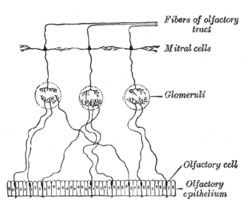| Glomerulus (olfaction) | |
|---|---|
 Coronal section of olfactory bulb. | |
 Plan of olfactory neurons. | |
| Identifiers | |
| NeuroLex ID | nlx_anat_1005011 |
| Anatomical terms of neuroanatomy | |
The glomerulus (pl.: glomeruli) is a spherical structure located in the olfactory bulb of the brain where synapses form between the terminals of the olfactory nerve and the dendrites of mitral, periglomerular and tufted cells. Each glomerulus is surrounded by a heterogeneous population of juxtaglomerular neurons (that include periglomerular, short axon, and external tufted cells) and glial cells.[1][2][3]
All glomeruli are located near the surface of the olfactory bulb. The olfactory bulb also includes a portion of the anterior olfactory nucleus, the cells of which contribute fibers to the olfactory tract.[4] They are the initial sites for synaptic processing of odor information coming from the nose. A glomerulus is made up of a globular tangle of axons from the olfactory receptor neurons, and dendrites from the mitral and tufted cells, as well as, from cells that surround the glomerulus such as the external tufted cells, periglomerular cells, short axon cells, and astrocytes. In mammals, glomeruli typically range between 50-120 μm in diameter and number between 1100 and 2400 depending on the species, with roughly between 1100 and 1200 in humans.[1][2] The number of glomeruli in a human decreases with age; in humans that are over 80 they are nearly absent.[5] Each glomerulus is composed of two compartments, the olfactory nerve zone and the non-olfactory nerve zone. The olfactory nerve zone is composed of preterminals and terminals of the olfactory nerve and is where the olfactory receptor cells make synapses on their targets.[2] The non-olfactory nerve zone is composed of the dendritic processes of intrinsic neurons and is where dendrodendritic interactions between intrinsic neurons occur.[2]
- ^ a b Pinching, AJ; Powell, TP (September 1971). "The neuropil of the glomeruli of the olfactory bulb". J. Cell Sci. 9 (2): 347–77. doi:10.1242/jcs.9.2.347. PMID 4108057.
- ^ a b c d Kosaka, K; Toida, K; Aika, Y; Kosaka, T (February 1998). "How simple is the organization of the olfactory glomerulus?: the heterogeneity of so-called periglomerular cells". Neurosci. Res. 30 (2): 101–10. doi:10.1016/s0168-0102(98)00002-9. PMID 9579643.
- ^ Wachowiak, M; Shipley, MT (August 2006). "Coding and synaptic processing of sensory information in the glomerular layer of the olfactory bulb". Semin. Cell Dev. Biol. 17 (4): 411–23. doi:10.1016/j.semcdb.2006.04.007. PMID 16765614.
- ^ Morris, H., & Schaeffer, J. P. (1953). The Nervous system-The Brain or Encephalon. Human anatomy; a complete systematic treatise. (11th ed., pp. 1034). New York: Blakiston.
- ^ R.L Doty. Neurobiology of Disease (2012). doi:10.1016/j.nbd.2011.10.026
